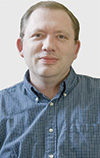As fields on the northern side slogged through generations of sugarcane and eventually rice production, many fields had been left to fallow as farmers, unions, workers and eventually nature itself took its toll on island production.
As these problems continued to persist, Juan Ponce, a third-generation farmer with a background as an attorney decided to do something very different.
His vision and determination brought about the success of J.P. Fantauzzi Beef and Hay Farm of Vega Baja, Puerto Rico.
Started in 1991, Ponce rented a section of fallow land from the Land Authority of Puerto Rico. The first several months were concentrated on draining land that had most recently served as rice paddies and were the furthest thing from pasture land. As the paddocks started to dry, roads, bridges, fences and pasture integration became the focus.

In order to get the most land established as quickly as possible, star grass and pangola grass were selected as the best options.
Introduced to the island in the late 1950s, star grass has become the grazing grass of choice as long as regular, well-timed rotation schedules can be followed.
In order to get the most from his pastures, Ponce divided his farm into 36 different paddocks ranging from 5 to 10 acres each.
Regular rotation through the paddocks with different groups of animals has allowed the established fields to flourish and even given rise to hay production from selected paddocks.
During the typical growing season, most paddocks are stocked at a rate of one cow-calf pair per acre, but during the rainy season, higher stocking rates can happen as long as the cows “tread lightly” on the paddocks.
Cows are allowed to graze each paddock for 14 days with a 21-day resting period between grazings.

Today, with the agribusiness slogan “Committed to Genetic Improvement,” J.P. Fantauzzi Beef and Hay Farm runs a closed herd of 170 purebred Brahman and Charbray animals. Every year, 35 to 40 purebred Brahman sires are sold throughout the island to improve the beef genetics.
With their natural adaptation to heat and humidity, these breeds have shown the best staying power on the island and several beef producers continue to return to Ponce for advice and genetics.
The farm uses a bolus tracking system for their animals. As the herd is moved from pasture to pasture through the scales and chute system, they can be monitored for growth rate and given any necessary vaccinations.
All data is recorded at the time of treatment. The Ponce family and staff has also paid special attention to animal treatment and worked to design a chute area modeled after the Temple Grandin system.

One side benefit of the operation was the opportunity to utilize some paddocks for raising hay. As his beef production grew, Ponce found he needed to keep his animals out of sight and more protected from possible theft.
What developed was a series of paddocks in the front half of the farm that were converted to full-time hay production, hiding the animals on the back half of the farm.
Today, 300 round bales weighing 600 to 700 pounds each are harvested every 10 weeks. This hay is sold to other beef and dairy farmers on the island or has come in handy to support his own herd when drought persisted.
It has created a balance to an operation that has risen out of the cane fields of past generations to create a business that adapts to the needs of this island community. ![]()
PHOTOS
PHOTO 1: Mr. and Mrs. Juan Ponce-Fantauzzi own one of the largest and most respected beef production farms in Puerto Rico.
PHOTO 2: Natural adaptations to heat and humidity have allowed the herd to not only survive but flourish in the challenging conditions on the island.
PHOTO 3: Each animal on the farm is monitored by a bolus system that allows tracking of growth rate and treatment protocols.
PHOTO 4: Stockpiled bales of hay can be utilized on the home farm or sold to other beef or dairy farms for additional income. Photos by Darren Olsen.









